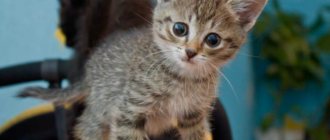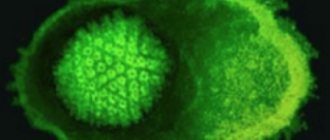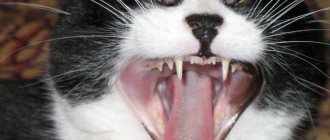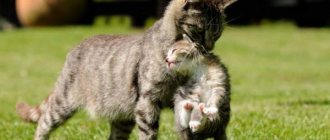6472Administration
1
Veterinarians often hear owners ask whether a cat can eat its kittens. Unfortunately, this phenomenon sometimes occurs and affects not only dead but also living cubs. This strange behavior occurs much less frequently in cats than in rabbits and pigs. However, a person who decides to start breeding cats needs to learn about their cannibalism in a timely manner in order to promptly take all the necessary measures to prevent this extremely unpleasant phenomenon.
The essence of the problem
The cause of cannibalism in cats may be genetic failures or heredity
Cannibalism is a phenomenon in which organisms are eaten by individuals of their own species. Currently, scientists know that about 1,300 species of living beings practice cannibalism to one degree or another. This number includes insects, amphibians, reptiles, birds, mammals and even humans. Cannibalism can be considered as a manifestation of intraspecific competition, a consequence of natural selection. According to scientists' observations, the cause of intraspecific predation is most often a lack of food and water caused by population overdensification or unfavorable environmental conditions.
As for cats specifically, cannibalism is inherent in them in extremely rare, if not exceptional, cases. Common causes include, for example, accidentally eating a kitten along with the placenta during birth, biting off tails or paws during excessive grooming, eating non-viable kittens, or postpartum eclampsia. The cause may also be genetic failures or hereditary cannibalism, when a cat receives the corresponding genes from its ancestors. It is noteworthy that there are no authoritative scientific works devoted to this phenomenon in cats, but based on the available materials, let's try to figure out what to do if you witness a cat eating its kittens, what reasons there may be for this, and warn newborn kittens against this.
What should owners do?
What to do if a cat carries kittens? This is the question that puzzles owners as they watch their pet looking for a new place for her offspring and transferring the cubs there.
First of all, it is necessary to understand the reasons that prompt the animal to such actions. Kittens should not be selected or placed in a place chosen by the owner. It is necessary to trace where the cat has found a new place and help build her a nest.
The animal should be denied access to places where the arrangement of a new place would be unsafe (balcony, space under the bathroom, etc.). Under no circumstances should you scold or punish a caring mother.
The animal obeys natural instincts and takes care of its offspring as nature dictates.
Owners sometimes misinterpret why a cat brings kittens to bed. You should not think that a caring mother entrusts her offspring to household members or brags about her kittens. Such feelings are alien to animals. The reason for the behavior is the search for a more favorable place for their offspring. And the master’s bed can be chosen as this place (warm, dry, clean).
There is also nothing touching about an animal dragging its cubs to a person. The reason why a cat brings kittens to the owner is, as a rule, a lack of food. The pet perceives humans as a source of food resources. As babies grow older, milk is no longer enough and they need solid food. This is why a cat brings its cubs to humans as a source of food.
Natural causes of cannibalism
cannibalism among domestic cats is more likely an accident, from which, however, we cannot be insured
It's more of a coincidence. From which, however, we are not immune. Among them, it is worth highlighting the killing of a kitten by a mother cat in her sleep. Cats are extremely kind and caring towards their own and sometimes other people’s offspring, but misfortunes do happen: cases when a cat carelessly strangles kittens with her body in a dream do occur. Accidents include murder by eating the placenta. After giving birth, the mother cat is extremely exhausted and exhausted. Feeling that there are life-giving substances in the placenta, cats often eat the placenta after the birth of the next kitten. It happens that a cat eats its newborn along with her. The fact is that it is not always possible to gnaw the umbilical cord without harming the kitten; as a result, the newborn may receive injuries incompatible with life. By the way, this is one of the reasons why owners need to be present during the birth of their pet and keep everything under control. From random reasons, let's move on to natural ones, in other words, why a cat can deliberately kill a kitten.
The kitten was born sick or dead
The cause of cannibalism among cats may be a natural instinct
Offspring with physiological problems can cause cannibalism in cats. Among the main reasons are the following:
- The kitten has congenital anomalies;
- The kitten was born sick or physically underdeveloped;
- A newborn with a cat mother has a different Rh factor of the blood, in this case the kitten is in mortal danger and without the intervention of the animal’s owners the kitten most likely will not survive;
- The cat ate a newborn who died of natural causes.
In the latter case, the cause of cannibalism was a natural instinct. Just like the placenta, it is a source of nutrients for her. Cats are not people; they do not tend to mourn the loss of their offspring. The same applies to nursing underdeveloped and weak kittens. A mother cat will not nurse such as humans would. If a cat sees that a newborn will not survive, it is more likely to kill it than to allow it to suffer and suffer, delaying the inevitable. This is the essence of natural selection. If you have witnessed a cat biting a kitten to death after giving birth, perhaps you shouldn’t be shocked; it’s just that she instinctively understands better than you who will live and grow up healthy and strong, and who was doomed from the very beginning.
Exhaustion of the cat
As we figured out, a mother cat can accurately “diagnose” her offspring, and she herself determines which babies she can feed for sure, so that the strongest representatives of the family can survive and continue the cat family. After all, it is extremely important that hereditary defects and diseases are not passed on to future generations. But this is not the only reason. Hunger can extremely rarely cause cannibalism in cats, but such cases have been recorded. If a cat eats other people's kittens, in addition to extreme exhaustion, it may be driven by a feeling of competition or jealousy. There are practically no described cases of hunger as a cause of cannibalism towards their offspring in domestic cats. But if you do witness your cat eating her kitten, the first step is to isolate the remaining kittens in a safe, warm and dry place. Take measures to calm the mother cat, possibly even using tranquilizers. However, no later than 24 hours later, return the kittens to the cat so that the babies can eat their mother’s colostrum.
Numerous litter
the large number of litters cannot be a reason for cannibalism among domestic cats
There are no mentions of such cases among domestic cats, but for wild nature this is normal. The reason is banal: cats are trying to help their offspring survive, given a large litter and a lack of food, the cat is forced to make a selection. In terms of food, the cat leaves the strongest and most physically fit kittens, and eats the weakest ones. Thus, the survival of the fittest occurs and the aforementioned natural selection occurs. Just as in the case of domestic cats, wild kittens are often born with severe defects, stillborn or dying immediately after birth; the mother cat also eats such kittens so as not to leave them for scavenger animals.
Prevention measures
Experienced breeders, when detecting such inappropriate behavior in a cat, remove it from further breeding, since cannibalism is inherited. The many reasons why a cat strangles her kittens make them difficult to identify. In this regard, the following preventive measures should be followed:
- Balanced and nutritious nutrition for a pregnant female with the inclusion of vitamin and mineral supplements in food. A veterinarian will help you get recommendations on creating the optimal diet for pregnancy and after birth. Monitoring the level of calcium in the blood to prevent postpartum eclampsia should be done through clinical analysis, since both high and low levels of the mineral in the body are dangerous;
- Preparing the nest in a secluded, quiet and safe place, inaccessible to outside animals. A thick cardboard box or exhibition box is suitable for these purposes. The nest should be placed in a dark place. It should be dry and warm. This organization corresponds as closely as possible to the natural conditions inherent in the cat at the genetic level.
- Observation of the birth process of the pet. Unobtrusive help from the owner will calm the mother cat and allow her to control the cat. If aggressive and inappropriate behavior of the mother is detected, newborns should be isolated. The animal, on the recommendation of a veterinarian, may be prescribed sedatives to calm the nervous system.
- Availability of food and water after birth. Food resources should not only be freely available to the cat, but also in close proximity to the nest. This will reduce the mother’s nervousness about leaving her babies in the nest, allowing the animal to quickly get enough and eliminate protein deficiency.
Cannibalism in domestic cats is a serious mental disorder based on ancient natural instincts. An animal with a predisposition to eating its own offspring should be excluded from breeding and breeding. Cannibalism has no cure. However, taking preventive measures will allow you to avoid such complex psychological deviations.
Similar articles
- A cat gave birth to dead kittens: what should owners do?
The reasons for the birth of non-viable offspring are varied. If a cat gives birth to dead kittens, what to do in this case and how to prevent stillbirth in the future, owners should have an idea... Read more - The cat attracts offspring: reasons and solution
There are always reasons why a cat drags kittens to different places, even if they are not so obvious at first glance. Animals are driven by natural instincts aimed at preserving their offspring. Read more
- The cat abandoned the kittens: what to do with the babies?
Most domestic beauties are excellent mothers, showing care and tenderness to their offspring. ... There may be several reasons why a cat refuses kittens: Reason. Read more
- The cat gave birth to kittens: what should the owners do next?
How to care for a cat and offspring after birth. ... If for some reason the nest was not prepared, then the first thing that needs to be done for the lambing cat is to prepare the nest for the mother and offspring. Read more
- Origin of cats: history of the species, from whom, where...
In addition to destroying mice and rodents, wild cats also hunted snakes, which was... You will learn about the causes of cannibalism in cats, provoking factors why a cat father destroys his offspring, symptoms of cannibalism... Read more
Pathological causes
Stress, mastitis or cesarean section can make a cat extremely aggressive towards kittens
The first birth for a cat is inevitably associated with extreme stress. We have already talked about the need for the presence of the animal's owners during childbirth. This is also necessary to make sure that all newborn kittens have attached themselves to the cat. Keeping kittens well-fed ensures they are calm, and the calmer the kittens are, the less stress your kitty is exposed to. If one of the kittens squeaks a lot and refuses to cling to the mother, it is better to feed it with a syringe with a special mixture for kittens and immediately return it to the mother. Make sure that during the birth and after nothing causes trouble for the cat: equip it with a personal space with a lounger, protect it from strangers or overly curious members of your family. This will also reduce the likelihood of stress for the cat. In addition to stress, illness can be the cause of such aggressive behavior in cats. Among which, for example, is mastitis - the course of the disease is accompanied by acute pain in the mother cat, while the animal can associate and identify clinging kittens with its painful condition, and this is fraught with the fact that the animal can behave aggressively and very seriously injure newborns. A cat that has been assisted in giving birth by caesarean section can also behave extremely aggressively towards kittens. In this case, the maternal instinct may simply not be formed. The pet will perceive newborns as strangers and may behave unpredictably. If you notice a cat's aggression towards kittens, it would be better to take the babies away from her. These are not all the reasons. Let's talk in more detail about other malfunctions in the animal's body that can cause cannibalism.
Psychical deviations
The most common cause of cannibalism in cats is postpartum eclampsia - an acute deficiency of calcium in the animal's body. The consequence of this disease is the cat’s extreme irritability, as a result of which she can behave extremely aggressively towards the offspring: eat, bite off the heads or hit newborns against the walls. Such a cat is sick and needs therapy because, along with mental disorders, eclampsia can end in death for the cat itself. However, initially, as a rule, neurological symptoms appear, when extreme irritation can push the mother cat to brutally kill her kittens.
Hormonal disbalance
The cause of cannibalism among cats can be both mental disorders and hormonal imbalances
As we found out, cannibalism in cats can be a consequence of diseases. According to medical evidence, it has been established that a cat can eat kittens due to a deficiency of the neurotransmitters serotonin. Cannibalism in cats is not a common phenomenon, for this reason, if a cat eats its kitten or several, and none of the above reasons can be the basis for its aggression, the following should be checked and excluded:
- Lack of vitamin B6 (pyridoxine);
- Problems with the pancreas;
- Excess calcium (the opposite effect of taking preventive medications for eclampsia);
- Deficiency of taurine (an essential amino acid for cats);
- Deficiency of animal fats (consequence of an unbalanced diet);
- Deficiency of niacin and tryptophan;
- Deficiency of other vitamins, such as vitamin K.
Of course, these reasons should be determined by a qualified veterinarian by examining laboratory tests.
Treatment
Why does a cat eat her kittens and does it need treatment?
Unfortunately, cannibalism is not a physical disease at all, so drug treatment is inappropriate. Eating one's own offspring is caused by stress or a failure in the instinctual system. The deviation most often appears during the first birth, and subsequently may never make itself felt again.
If a cat has a persistent tendency towards aggression towards its offspring, it is worth blocking the possibility of reproduction. Since there is a high probability of manifestation of this disorder in subsequent generations.
However, this reaction of the animal can be caused by hormonal imbalance. In this case, prophylaxis is prescribed. Progestins are used to correct disorders.
cat and kitten
Why does a cat eat kittens?
if it happened that someone else’s cat bit the kitten, most likely there was intent on the part of the cat
We talked about cats. Now let's focus on cats. Why do cats kill kittens? Do daddy cats eat their kittens? Why do they do this and how often does this actually happen? Let's figure it out.
According to reliable information from open sources, it becomes clear that cats rarely kill kittens and mostly through negligence, by crushing or strangling them. Therefore, if in your house there is a mother with offspring, an adult cat and no other males, there is nothing particularly to worry about. However, like cats, some males inherit cannibalism. So, could it happen that the cat killed the kitten because he was a cannibal? Unfortunately yes. Can a cat bite a kitten for this reason? Yes too. If a cat killed a kitten, can it be said that hereditary cannibalism was the cause? Most likely this is true. But statements that an adult cat is capable of killing kittens considering them to be future competitors, due to the lack of paternal affection, or will strive to kill kittens from a competing cat are groundless and have not been confirmed. The situation is completely different, if someone else’s cat killed a kitten, there may indeed be intent. But it is not based on competition, as is typical, for example, of lions; most likely, if a cat killed kittens from another father, this has nothing to do with their father, but with their mother. In this way, the cat provokes the cat into a new heat as soon as possible, in order to cover her up. After all, while the female has kittens, she most likely will not breed, but by killing one or all of the cat’s offspring at once, the cat will have a chance.
Reasons for eating offspring
Cannibalism is the eating of one animal of a given species by another. Distributed mainly among fish, insects, and sometimes found in warm-blooded animals. Females are more aggressive than males. And the reasons are often due to a change in habitat, preservation of offspring, and hunger. It occurs much less frequently in domestic animals.
However, you should not breed pets more than once a year. After giving birth, it takes time to recover, otherwise the cat may eat the stronghold, as it will be exhausted and will not be able to produce healthy offspring.
Cat eats kittens
Measures to prevent cannibalism
to prevent cannibalism, exclude provoking factors during childbirth
Perhaps we can say that we have found answers to questions related to cat cannibalism. We can conclude that if such a situation occurred by accident or because the kitten had a pathology from birth, then there is nothing to worry about and no measures need to be taken. But if a cat shows aggression towards its offspring not for the first time and for no apparent reason, then it is better to sterilize it and no longer use it to produce offspring. This is evidence of a genetic tendency towards cannibalism, which will almost certainly be inherited. It is also recommended to sterilize or castrate kittens from such a mother, because they will most likely carry the gene for cannibalism.
In order to prevent cannibalism, it is extremely important to prevent provoking factors during childbirth. Here are some tips to consider if your cat is getting ready to become a mother:
- Monitor your pet closely if she is in an unstable mental state, such as being irritable, aggressive, or overactive.
- Take the pregnant woman to the veterinarian regularly, take care of her comfort, and provide her with proper care.
- During pregnancy, your cat needs your extra attention. Provide her with a secluded, warm and dry place where the animal can feel completely safe.
- During birth and immediately after, there should be no strangers near the cat and kittens. But for the reasons described above, you can’t leave your pet alone either. Take care of an observation post for yourself in advance so that, if necessary, you can assist the woman in labor and save the lives of the kittens.
By following these simple recommendations and taking into account everything discussed in this article, you can almost certainly say that if you have encountered cannibalism in cats in the past, now you know enough about its causes, which means you have something to counter it. If your cat is just preparing to become a mother, you have enough knowledge to protect future babies and prevent aggression towards them from the pet.
How can you tell if a cat can eat kittens?
It is impossible to be 100% sure whether a cat can eat its kittens or whether a particular pet will avoid this attack. There are several warning signs that can be seen with the naked eye.
- During pregnancy the animal became very irritable.
- Nervousness appears after childbirth. Runs away from kittens, cannot sit in one place.
- Initially, the pet is hyperactive.
- There are other animals on her territory with access to her offspring.
But what to do if the cat ate the kittens? Under no circumstances should she be scolded, beaten or even thrown out of the door. What has been done cannot be undone, and the animal will be left with psychological trauma, which can affect subsequent births and attitudes towards motherhood.
Reasons that force a cat to hide kittens
There are always reasons why a cat drags kittens to different places, even if they are not so obvious at first glance. Animals are driven by natural instincts aimed at preserving their offspring. Most often, a caring mother transfers her kittens for the following reasons:
| Cause | Reasons for animal behavior |
| Excessive curiosity of household members towards newborn babies | The animal worries that even the beloved owners often look into the nest, ceases to perceive the place as safe, and seeks to hide the cubs. The chosen place does not meet the safety conditions. In nature, the priority when choosing a nest is secrecy, secrecy from prying eyes, and inaccessibility to predators. Therefore, the cat chooses secluded corners for its offspring, where it can safely feed the cubs. If for some reason the place becomes restless and open, the cat tends to find another nest and drag the kittens into it |
| The cat drags the kittens to a new place, usually when they grow up and switch to solid food | At approximately 3-4 weeks of age, the offspring “moves” closer to food resources (to a bowl of food). Milk is no longer the main food of the cubs at this age, and the female tries to place a new nest closer to the food source |
| Inadequacy of the bed for raising offspring | The place with kittens can be cold, damp, hot. Drafts, excessive light, proximity to other animals are often the reason why a cat drags kittens to another place. When the nest loses its neat appearance over time due to excrement and litter contamination, the caring mother will also look for a new, cleaner home |
| The place for kittens is not suitable for their size | The cause of a cat's anxiety can be either a nest that is too large or a nest that is too small. At first, when the cubs are small, the cat may not like a spacious box. A place inappropriate for the size of the litter seems unprotected to the animal, vulnerable to enemies, and she begins to drag the kittens. This phenomenon is often observed on the 2nd - 3rd day after lambing. |
| Owners often observe how a caring mother constantly carries the same kitten and hides it. The reason why a cat takes one kitten away from others may be its poor health or excessive activity. | In the first case, the cat tries to provide the sick baby with a better place. If the baby screams the loudest, then the mother can take him away to ensure the safety of the rest of the offspring. In the wild, a predator will quickly find a nest because of a noisy kitten, and the female will take the source of noise away from the rest of the cubs |
| The reason for persistently dragging your offspring may be postpartum eclampsia | This pathological condition occurs due to a lack of calcium in the body, which is accompanied by a disorder in the animal’s nervous system. After childbirth, females become restless, aggressive, and inadequate |
| The selected location does not meet safety conditions | In nature, the priority when choosing a nest is secrecy, secrecy from prying eyes, and inaccessibility to predators. Therefore, the cat chooses secluded corners for its offspring, where it can safely feed the cubs. If for some reason the place becomes restless and open, the cat tends to find another nest and drag the kittens into it |
Kitten care
If it has already happened that the cat abandoned the kittens, it is important for breeders to know what to do and act without wasting time, since without care (from the mother or owner), the babies can simply die in the first hours after birth. You will need:
You will need:
- warmer;
- towel (soft but natural);
- feeding device with nipple;
- milk replacer (sold in veterinary pharmacies).
Important! Never try to feed newborn kittens natural cow's milk or store-bought milk. Their composition is far from the baby’s needs and can cause irreparable harm to the kitten’s body.
We bring to your attention an average feeding table for newborn kittens, which will be relevant when using a special cat's milk substitute.
| Age | Volume for 1 feeding | Feeding frequency |
| 1-3 days | 2.5 ml of feeding cat milk replacer for newborn kittens is harmful when used. birth. lecture Xia. all yours | every 2 hours |
| 4-7 days | 5 ml | every 2 hours |
| 6-10 days | 5-7.5 ml | every 2 hours |
| 11-14 days | 10-12 ml | every 3 hours |
| 15-21 days | 10-15 ml | 8 times a day |
| after 21 days | 10-25 ml | 3-4 times a day |
Important! When purchasing a special food, be sure to read the manufacturer’s recommendations, as the dosage may differ from that shown in the table. The mixture should be barely warm, otherwise you can easily burn your baby’s esophagus
The mixture should be barely warm, otherwise you can easily burn the baby's esophagus.
After each feeding, it is important to gently massage the kittens’ tummies, because this is how the mother cat stimulates the newborn to have bowel movements. At the 4th week, you can gradually introduce solid food into the kittens’ diet and teach the babies to eat a bowl.
At the 4th week, you can gradually introduce solid food into the kittens’ diet and teach the babies to eat a bowl.











